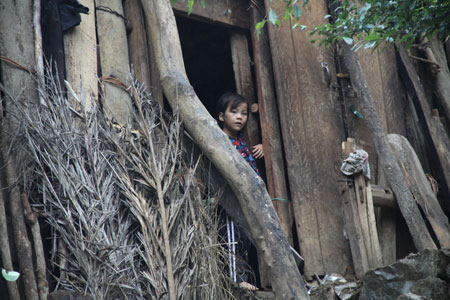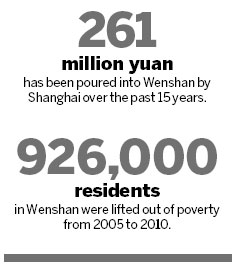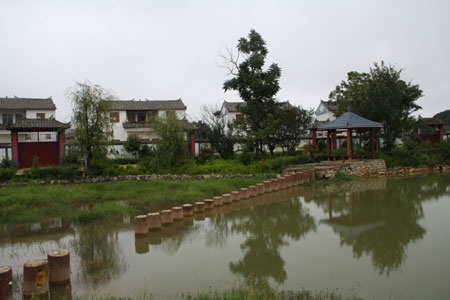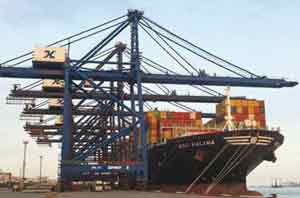Rural revival
Updated: 2011-11-07 07:52
By Xu Taotao (China Daily)
|
|||||||||
|
The poverty-stricken village of Ma'anshan in Yunnan province's Wenshan prefecture is getting a new look with the financial assistance of Shanghai. Photos by Chen Ping / For China Daily |
|
 Yao people live an isolated life in the mountainous Funing county in Wenshan prefecture. Any visitors may arouse great interest among local villagers like this shy girl hiding in her wooden house. |
A government initiative that pushes wealthy regions to assist poorer parts of the countryside is transforming farmers' lives. Xu Taotao reports.
Tian Jinyu and his family never imagined they could escape poverty and live in a modern two-story house with a spacious yard.
But the agrarian household in Yanshan county in Yunnan province's Wenshan Zhuang and Miao autonomous prefecture now earn more than 8,000 yuan ($1,262) per capita and dwells among three such homes, two of which belong to his sons.
Theirs are among 57 high-quality dwellings built in Ma'anshan village through government initiatives that push wealthy cities to assist underdeveloped areas. The system, which pairs a rich urban district with a particular poor area, has been hoisting thousands of rural dwellers out of poverty since the 1990s.
Wenshan, for instance, is one of four Yunnan prefectures Shanghai has been designated to help.
The metropolis has poured more than 261 million yuan ($41.16 million) into Wenshan over the past 15 years, during which time it constructed 760 new villages.
It has lifted more than 926,000 Wenshan residents out of poverty between 2005 and 2010.
Tian's house didn't cost him much. Shanghai paid for the tiles and bricks, and the county subsidized other costs.
The county also acted as a guarantor of his 50,000-yuan house loan from a local bank, which Tian paid off in three years.
While this summer's severe drought damaged Tian's corn crop, a bountiful red chili pepper harvest spills out of his storehouse.
Tian believes his household income, which was about 2,000 yuan several years ago, might continue to increase with the peppers' market prices.
Director of Yanshan county's poverty alleviation office Huang Jiaxiang says about 4.39 million yuan has been invested in Ma'anshan village's development. About 1 million yuan was spent by Shanghai's Zhabei district, while an additional 1.79 million yuan came from the local government. Villagers also raised about 1.61 million yuan.
Ma'anshan's transformation has brought new roads, tap water, a methane pool, a reading room and a sports arena.
Research into optimizing local farmers' livelihoods has made production of chili peppers, cured tobacco, walnuts and pork the four local pillar industries.
Shanghai's contributions also funded construction of a standardized pig ranch, which has significantly raised local incomes. Every household can buy piglets to be raised with other villagers' at the 1,500-square-meter ranch, which now has more than 200 pigs.
About 97 percent of Wenshan's land is mountainous, which has made it difficult for the 10 ethnic groups who inhabit its terrain to develop the local economy.
But officials from outside have been discovering solutions.
 |
The deputy head of Wenshan's Xichou county, Tian Yan, says Shanghai's Hongkou district explored potential ways to overcome poverty according to the area's local conditions after it constructed Xiaodong village. It discovered kiwifruit production offered great potential.
One Shanghai official had shared his success with growing kiwifruit in Sichuan province's Dujiangyan city at a conference of Shanghai officials assigned to assist rural areas' development. The official found similarities in the climates and soils of Dujiangyan and Xichou, and decided to try growing kiwifruit in Xichou.
Experts from Sichuan were sent to assess Xiaodong's natural conditions and teach villagers how to grow kiwifruits two years ago.
Two new kiwi varieties - Hayward and Hongyang - were successfully harvested.
The experimental plot expanded to about 13 hectares, reaching the primary stage of large-scale production. A kiwifruit growers' cooperative was also established.
The business proved to be lucrative, as the plants flourished and the new species' market value increased, generating more than 1 million yuan in annual revenue.
"The money from growing kiwifruit has allowed me to support my children's middle school educations," a Xiaodong villager surnamed Zhe says.
"I'm very happy with this new source of income."












